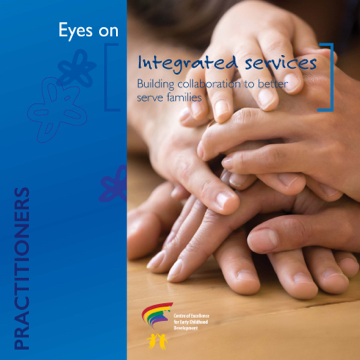This topic provides an overview of the benefits of integrated and coordinated early childhood development services in order to meet the needs of families and young children in a coherent way, and presents some models that have proven effective.
Synthesis PDF Complete topic PDFInformation sheets
Download the free PDF version here or purchase hardcopy prints from our online store.
Integrated early childhood development services
Integrated services: Building collaboration to better serve families

Synthesis
Topic Editor:
How important is it?
Parents fill multiple roles in the life of their children, such as caregiver, teacher, nurse, safety officer, nutritionist, and moral guide. They are also their children’s first and most important advocates and care coordinators, seeking help from a variety of services—health, education, child care, social or other family support services. Yet in some cases, parents are not able to find or afford appropriate resources to meet their children’s needs. Moreover, disadvantaged families, especially in culturally diverse and deprived neighbourhoods, may have multiple needs.
Children’s developmental outcomes may vary depending on the extent to which these services are integrated together to form a cohesive system that can be easily accessed by families. Specifically, fragmentation of services often results in a lack of consistency and continuity for children and families. When children are seen by multiple service providers, parents may receive mixed and conflicting advice, limiting the effectiveness of these services and adding to parents’ confusion and stress. Integrated services can provide a more accessible, aligned and coordinated response that is better suited to children’s and families’ needs.
What do we know?
When children need services in multiple areas, programs and policies that bring together different services lead to better results for children and their families. When focused on the parents as well as the child, validating and supporting parents in their roles, programs can also improve parent-child relationships and children’s healthy development across physical, cognitive, social and behavioural development.
Over the past two decades, many programs offering integrated early childhood services have been implemented worldwide. Most of them were created in order to: 1) improve children’s health and overall development; 2) provide support to families; 3) decrease gaps in school readiness; and 4) reduce the negative outcomes associated with living in poor neighbourhoods. Early Head Start, Sure Start, Better Beginnings, Better Futures, and Toronto First Duty are examples of both broad-scale government programs and demonstration projects that have also been the object of an evaluation in previous scientific studies.
Early Head Start
Early Head Start is an American federal program created in 1995 to serve low-income pregnant women and families with infants under the age of three. This program offers high-quality child development services through home visits, centre-based child care, health care, and case management. It integrates two-generation programming and aims to establish community partnerships to increase the availability of services to families. Benefits resulting from the implementation of this program include improvement in children’s socio-emotional development starting at age two.
Sure Start Local Programs (SSLPs)
SSLPs have grouped health, social, and educational services to help poor children under the age of five and their families in England since 1999. Over time the mandate to integrate these services has been strengthened, evolving from a variety of community networks to more coherent children’s centres. Evidence suggests that greater integration leads to more benefit. Several positive developmental outcomes have been found for all sections of the populations living in SSLP areas, including improvement in child’s health at age five (e.g., less severe injuries and respiratory infections) and in several aspects of school functioning for older children. Mothers showed improvement in life satisfaction and the home learning environment, with less harsh discipline.
Better Beginnings, Better Futures (BBBF)
BBBF is a project that examined the impact of integrated services in eight economically disadvantaged communities in the province of Ontario, Canada. Initiated in 1993, it was designed to reduce emotional and behavioural problems in children (0-8 years old) and to strengthen parents’ abilities to meet their children’s needs. A variety of high-quality services were offered to children and their families, including health, social, educational, and family support services. In terms of impact, the creation of partnerships with community service providers increased the visibility and the funding for programs. It also increased the collaboration among service providers which in turn led to the development of new settings to offer services to children and families. Positive developmental outcomes were found in 4- to 8- year-old children and their families, and measures collected when the cohort was in Grade 12 indicated lasting outcomes. Data collection has continued into adulthood, making this one of the longest Canadian longitudinal studies of an early child development program.
Toronto First Duty Project (TFD)
TFD is a project that began in 2001 to test the impact of integrating kindergarten, child care, and family support and health services into a single hub for children 0 to 6 years old and their families in the greater Toronto area. Positive impacts of this project included an increase in parental engagement with school and decrease in parental stress from negotiating disconnected kindergarten and child care arrangements. In addition, more intense use of these services benefited children’s physical health and well-being, language and cognitive development, and communication and general knowledge.
What can be done?
In order for programs to be effective and part of a cohesive system, some important aspects should be considered. First, given that collaborations across agencies provide the best results, service providers should not work independently but rather try to establish collaborative relationships with other community organizations (e.g., by sharing information). Providers from different sectors (education, health, nutrition, family support, etc.) must be able to refer children and their parents to services outside their professional purview, and coordinate with each other when serving the same child and family.
A crucial step for successful integration is developing common goals to guide their partnership activities. Effective partnerships will depend on commitment at all levels, with clear roles and responsibilities, and regular communication to develop trust. Professionals also need time to manage this organizational change.
Service providers should keep in mind that making the services available is not sufficient. For families to be aware of and benefit from them, services also need to be affordable, accessible, and active in outreach. Some families may lack resources or face social/economic circumstances preventing them from accessing these services. Therefore, coordination between services and development of strategies to reduce barriers are two important aspects to privilege before implementing a program. Evaluation of implementation and continuous monitoring of outreach also need to be built in.
Finally, integration and sustained collaboration among agencies will require program and policy support from different levels of government, as well as strong grassroots support to withstand government and policy changes.
Discover more

What do integrated early services do?
Parents are the primary caregivers to their children. They play the role of early teacher, nurse and moral guide.
Sometimes, however poverty or other factors make it difficult for parents to coordinate all these roles to best meet their children’s needs.
Integrated early services include a range of services such as health screening, family supports and early childhood education. These can level the playing field for children at risk, especially those from different socio-economic backgrounds and poor neighbourhoods.
Above all, integrated early services are the perfect example of how by working together towards a common goal, parents and communities can help children thrive and reach their full potential.
Publications
What Young Children and their Families Need for School Readiness and Success
Early Childhood Education and Care Systems: Issue of Tradition and Governance

Resources and bulletins
The Encyclopedia also recommends...
March 2017 - Published by the Canadian Council on Social Determinants of Health (CCSDH), in collaboration with the Centre of Excellence for Early Childhood Development (CEECD)
National Evaluation of Sure Start (NESS)
Birkbeck University of London, United Kingdom




